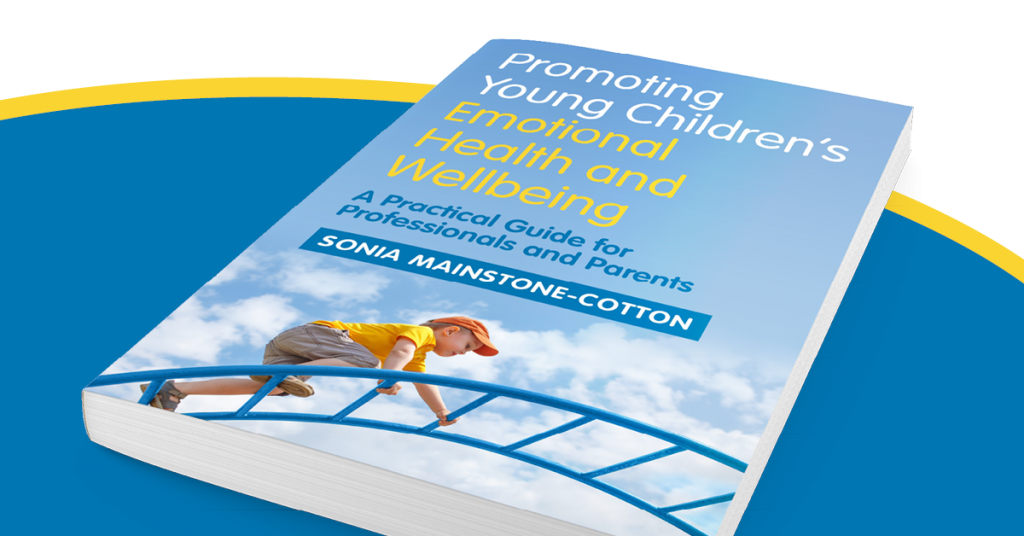Sonia Mainstone-Cotton, author of Promoting Young Children’s Emotional Health and Wellbeing, provides some very useful and easy tips for supporting young children’s happiness at this important stage in their development.
Wellbeing is a term we hear a lot about for adults and young people, but we don’t hear so much about it for young children. We know that the rates of teenage mental health problems are rising alarmingly, and we are aware that children and young people are feeling increasingly stressed and distressed. I passionately believe if we can help young children to have a good wellbeing then we are setting them off to a great start in life. But to help children have a good wellbeing, we need to be proactive about it.
One critical aspect of a child having good wellbeing is by them knowing that they are loved – that they are loved for the unique and precious individuals they are. Parents and grandparents clearly have a crucial role in letting children know that they are unconditionally loved, but I also believe that key workers, teaching assistants, children’s workers also have a role in showing children that they are loved and wanted. We show this through the words we use and the way we hold children. Part of my job is as a nurture consultant; I have seven children and schools that I support throughout the year. Every time I see one of my nurture children I ensure I show delight in seeing them that day. I smile at them, I look them in the eyes and tell them how lovely it is to see them today, how much I have been looking forward to our time together.
If you work with children, think about how you welcome them each day. By showing warmth in your smile and your words, through noticing how they look; maybe they have a spiderman hat on or a new hair band in their hair. Through seeing things that are important to the children and telling them how delighted you are to see them, this helps a child to arrive feeling wanted and loved.
In my new book Promoting Young Children’s Emotional Wellbeing, I explore a few essential ways we can further help to embed this. Below are a few examples:
Playing outside – There is so much research showing the need for children to spend quality time being outside. Giving children opportunities to explore, discover, climb, run. As parents we can do this by taking walks each day, going to the park, going to a field. Playing bubbles outside is a joyful and cheap activity to do with children outside.
Sensory play – Giving children the chance to explore with all their senses. Children learn better through exploring and using all their senses together. A very simple example of sensory play is play dough; you can buy this very cheaply or make your own (there are many recipes on Pinterest)
Using emotional language – We need to help children understand their feelings and emotions, by using emotion language and giving them an emotional vocabulary we are enabling them to understand their feelings and also other peoples. From babies we can start to talk about their feelings, e.g when a baby is crying to be fed we can respond with gently saying ‘It’s OK I know you are feeling hungry, I am going to feed you now’. With a toddler who is crying because their parent has left them at nursery we can say ‘I can see you are really sad that Mummy has gone, she will be back later I am here for you now”.
Un-rushing & stillness – Our lives are often very busy, and our children’s lives are often busy too. We need to help children to find times to rest, to experience moments of stillness. Are there spaces in your setting or your home where your child can lay back and relax or daydream? You can also use yoga and mindfulness with young children; both of these practices help children to find stillness. CBeebies have a children’s program called Waybuloo which teaches different yoga poses.
Being creative – Creativity is an essential part of wellbeing. We need to give children the space to be creative and to be creative with them. Find times to sing and dance with your children, dancing and singing together with your toddler can be a joyful experience. Giving children the opportunity to experiment with paint, chalks, making things with cardboard boxes – these will all help your child’s wellbeing.
Be co-explorers – Children have a passion for learning and discovering, they need adults around them who want to learn and explore with them. I believe one of our roles as adults is to be a co-explorer and adventure with our children. Children are great at becoming fascinated in something, this might be the snail and sticks on the road as you are walking to the shops, or it may be a fascination with dinosaurs. As adults, we can show interest and delight with children and learn alongside them.
Our wellbeing – and finally, if we are going to help children to have a good wellbeing we need to pay attention to our own wellbeing. We need to take care of ourselves; we need to ensure we are eating well, exercising, having rest and doing things which make us happy.
If you would like to read more articles like Sonia’s and hear the latest news and offers on our Early Years books, why not join our mailing list? We can send information by email or post as you prefer. You may also be interested in liking our Special Educational, PSHE and Early Years Resources Facebook page.
